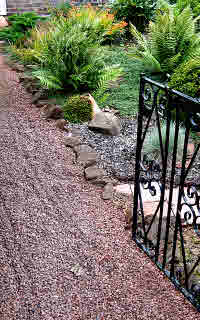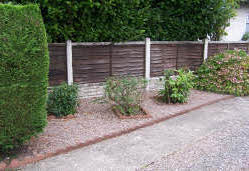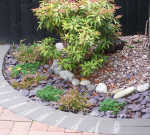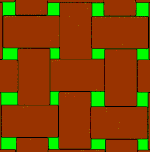Landscape Mulch
* Help & ease for keeping surrounds neat & tidy,
* Add a natural texture over a large area,
* Maintain continuity of style.
This page looks at landscape mulches - gravels, forest barks and associated fabrics. I compare their properties, uses, and describe how to apply them.
You may want landscape mulch to enhance the soft landscape around your house and along pathways. Crunchy gravel for example is well-used on house approaches to provide an alert to the presence of visitors. Well-chosen stone colours can blend beautifully with house walls, rock and water features and the local natural environment.
Decorative gravels
Further from the house permanent planted areas such as shrubberies and rock gardens are good sites for landscaping. Mulch can set the tone here too and provide a neat low maintenance area. Organic cocoa shell and bark for example add aroma, and the essence of a natural forest setting to your garden experience.
Forest Bark, Woodchip, Play & Decorative, free delivery available
These landscape mulches add continuity, colour, and texture. Don’t’ forget that the size of stones, chippings etc... influences the awareness of space within an area.
What you don't see here
is the sheet underneath
the gravel
is the sheet underneath
the gravel

>
>
>
>
>
>
>
>
>
>
>
Permeable & Green Utility Areas
>
Planting Pockets, Tubs & Containers
>
Paving & roll out paths coming soon...
MORE PAGES ABOUT GARDENING WITH MULCH
PERMEABLE BARRIER MEMBRANES
It is common practice to underlay these materials with a landscape membrane or geotextile. This forms a permeable barrier. But with organic mulch - wood chip, bark and the like, this is not necessary as these rot down to feed the soil. My natural instinct is to avoid barriers that cut off the soil, worms, and soil microorganisms etc… from the surface.
 However, with the harder and heavier gravels and stones, a membrane prevents sinkage into the lighter soil base and the soil base from rising into the gravel layer. This is especially important when the gravel is used to carry traffic.
However, with the harder and heavier gravels and stones, a membrane prevents sinkage into the lighter soil base and the soil base from rising into the gravel layer. This is especially important when the gravel is used to carry traffic.
But if weeds were to seed into the mulch and grow from the top down, their roots might penetrate any permeable underlying barrier. This complicates weeding as it may tear the membrane. The advice on this says - don't exceed the recommended depth of mulch (details below). A barrier membrane also prevents tree roots from growing up into a loose mulch.
Landscape mulches also keep the underlying soil cool and moist during summer.
You can usually find a way to plant through landscape mulches. Under gravels that will require cutting through the barrier membrane. Therefore it’s best to plan your planting scheme before you start and cut an X through the membrane wherever a plant is to go.
^ Top of page
WOOD CHIP LANDSCAPE MULCHES
Larger sized wood chip has an advantage over bark of being less likely to be blown away. Nowadays a range of decorative wood chips are made for gardens.
The depth of mulch for paths should be around 50mm. For children's play areas it should be around 300mm and geotextile under membrane may also be considered.
GRAVEL LANDSCAPE MULCHES
Gravels can be used with planted garden areas: borders, cottage garden paths, rock gardens, around water, and to make stone features. Gravel can also be used for utility areas: in greenhouses, access paths, drives and parking areas.
You may find that small sharp gravels and grit deter slugs. But some gardeners find that small polished gravels are used as a toilet by cats.
 Gravel size is an important factor influencing texture and awareness of area. Think about scale. Small areas can look more extensive when a small size gravel is used. But the scale of plants, rocks, and other features also play a part.
Gravel size is an important factor influencing texture and awareness of area. Think about scale. Small areas can look more extensive when a small size gravel is used. But the scale of plants, rocks, and other features also play a part.
In utililty areas the gravel should be at least 6mm in size to prevent it being kicked around. The largest size that is comfortable for walking on is about 20mm and 10-20mm grade might typically be used for driveways. Details on drive construction are beyond the scope of this website. But the gravel layer for a typical garden path might be around 30-40mm deep.
^ Top of page
SHALE AND FLAT STONES LANSCAPE MULCHES
Flat stones of shale or slate add a another interesting perspective to the ground. They are typically used on a scree garden. You may consider shale or slate as landscape mulch for your paths.
 PERMEABLE DRIVES AND PARKING AREAS
PERMEABLE DRIVES AND PARKING AREASThe problem with block paving and concrete paths is they prevent natural rain seepage and cause run off. Also, they are not very desirable to someone who enjoys diverse greenery. This section is about garden friendly utility landscape surfaces - alternatives to landscape mulch.
Nowadays several permeable alternatives are available.
- Block Paving laid out with spaces for sowing grass
- Hopsack arrangement of blocks to create intervening spaces for sowing grass
- Blocks with added spacers allows wider spaces for sowing
- Cellular Paving using hexagonal polypropylene units that interlock.
^ Top of page
You could use the above systems with any suitable plants in addition to grass. May I suggest clover or medicago, as these will fix the nitrogen into the soil helping to feed the grass. Ajuga, Lamium, and the scented Anthemis nobilis (Chamomile) are other possible choices. Rye grass is of course the toughest for a utility area.
- Grass Protection Mesh - this is pegged down over grass in parking areas and can prevent rutting and muddying of the turf.
- Soil Retention / Protection Mesh and Blankets - these are made of natural materials and biodegradable. They hold the soil in place reducing erosion before grass germinates and establishes.
PLANTING POCKETS, TUBS AND CONTAINERS
Grit and gravel are also used to top off pots and containers. They act as mulch to keep the pot soil surface moist and they suppress weeds. Planting pockets in patios and pavement, and along walls and paths are also nicely finished for with ornamental gravel mulch.
COMING SOON...
PAVING STONES AND ROLL OUT PATHS
BOTTOM OF THE GARDEN - more information and links
BOTTOM OF THE GARDEN HEAP - more information and links
Find more links about Flower Gardening below:
|
Flowers For
Home |
More Help On
Flower Garden Design |
Grow Your
Own Flowers |
|
|
> > |
> > > |
> > > |
> > > |
ALSO on the-organic-gardener.com
-
My Neighbour's Flower Garden Design
The Flower Expert is here.How to make a beautiful & productive garden with Sarah Raven - click link.
The Royal Horticultural Society is on this link plus... ...
Pictures of the growing landscape for the London Olympics
Do you run a gardening website - with information to interest my visitors? To set up exchange links from/to suitable pages - click here.

Custom Search
- The Home Of The Organic Gardener - growing naturally, pure and beautiful.
^Looking on top with Landscape Mulch

Copyright © The Organic Gardener.Com 2004 - 2020.

[?] Subscribe To This Site
- Organic Garden Blog
- Grow More Flowers
- Grow From Seeds
- Grow Better Lawns
- Grow Potatoes
- Organic Fertilizer
- Weed Control
- Garden Tool Shed
- Garden Power Tools
- Garden Shredders
- Grow With Compost
- Gardening Gifts
- Gardening Books
- Crop Rotation
- Organic Pest Control
- Runner Beans
- Mulch It
- Garden Watering
- Moving Shrubs
- About Organic
- About the Gardener
- Organic Links
- Contact the Gardener
- Privacy Policy



